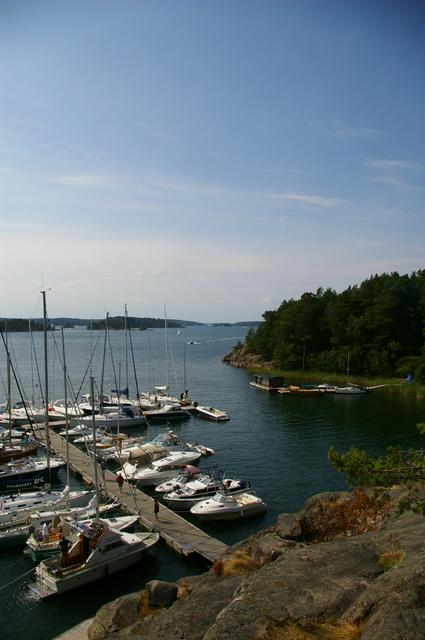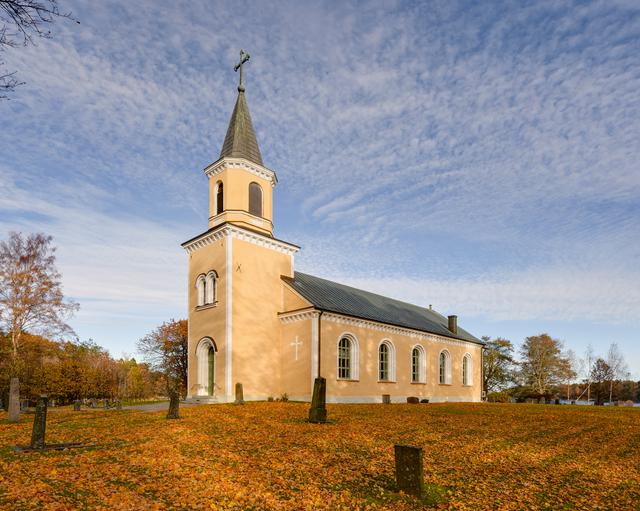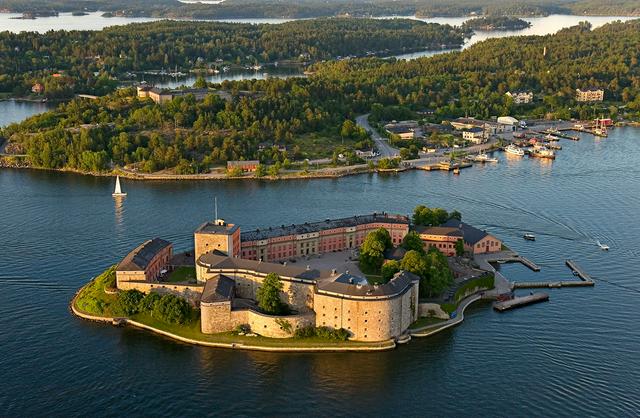The Stockholm archipelago, Stockholms skärgård or (locally) skärgården, is a group of thousands of islands in the Svealand region, extending east of Stockholm in the Baltic Sea. While many of the islands are relatively small, two large ones, Värmdö and Vaxholm, stand out as major destinations.
Since the Ice Age ended, the land has been rising from the Baltic Sea, changing the sceneries over generation; see Nordic countries#Geography.
In modern times, the archipelago consists of at least 24,000 identified islands, islets, and skerries.
From the Middle Ages until the end of the Cold War, the Swedish military has had troops, ships and fortifications in the archipelago, to defend Stockholm. The only major enemy attack on Stockholm was committed by the Russian Empire during the Great Northern War, in 1719 to 1721. In the early 2000s, most defense facilities closed down, commmemorated by the Vaxholm Fortress Museum, or converted for civilian housing.
The local population relied on subsistence fishing and farming, isolated from Stockholm's tremendous progress in the 19th century, as tourists started to colonize the area. During the 20th century, many of the outer islands were de-populated, and transformed to summer resorts, with very small population during winter. Today, most island-dwellers commute to Stockholm for work, and enjoy maritime life as a hobby. In contrast, many of the inner islands have become suburbs of Stockholm.

 Just as the rest of Sweden, the Stockholm Archipelago is divided between municipalities, kommuner. From a traveller's point of view, the major islands are more useful as divisions.
Just as the rest of Sweden, the Stockholm Archipelago is divided between municipalities, kommuner. From a traveller's point of view, the major islands are more useful as divisions.
- Furusund. — is an island where Astrid Lindgren, August Strindberg and many other writers and painters spent their summers. Also Norröra and Söderöra are in the same region, off Norrtälje.
- Grinda. — is a small rural island, near Stockholm and Vaxholm, good for a one-day excursion.
- Lidingö. — is a suburban island near Stockholm, described in its own article, together with Fjäderholmarna.
- Ljusterö. — is the largest island in the archipelago without a bridge to the mainland. It is served by a ferry from Östanå.
- Sandhamn. — is the largest island in the outer archipelago, known for its summer nightlife.
- Utö. — is an outer-archipelago idyllic island with a closed-down silver mine, and remnants from the mining industry. Do not confuse with Utö in Finland, across the sea.
- Vaxholm. — (archaic spelling Waxholm) is a quaint island-town connected to the mainland, with a historical fortress, a variety of boutiques, and a major ferry terminal to the northern archipelago.
- Värmdö. — (archaic spelling Wermdö) is the largest island in the archipelago, accessible by road. It contains suburban neighbourhoods as well as deep forests, lakes and beaches, similar to the Swedish mainland. Gustavsberg is the main town. Stavsnäs is a major ferry terminal for the southern archipelago.
- Öja. — is an elongated island, at the southern edge of the archipelago, off Nynäshamn. The Landsort lighthouse on Öja is an important landmark when arriving from Gotland.
This article also describes some mainland destinations associated with the archipelago.
- Åkersberga. — The entire Österåker municipality is included in this article, despite the fact that most of it is on the mainland. Österåker municipality's largest town is Åkersberga where also the municipal seat is located.
- Saltsjöbaden. — is a waterfront suburb for the well-to-do, at the end of Saltsjöbanan, a rail line from central Stockholm. It was built up around 1900, and is famous for its observatory, the Grand Hotel, and the acclaimed sitcom series Solsidan.
Åkersberga. — The entire Österåker municipality is included in this article, despite the fact that most of it is on the mainland. Österåker municipality's largest town is Åkersberga where also the municipal seat is located.
Saltsjöbaden. — is a waterfront suburb for the well-to-do, at the end of Saltsjöbanan, a rail line from central Stockholm. It was built up around 1900, and is famous for its observatory, the Grand Hotel, and the acclaimed sitcom series Solsidan.
Furusund. — is an island where [[Astrid Lindgren tourism|Astrid Lindgren]], August Strindberg and many other writers and painters spent their summers. Also Norröra and Söderöra are in the same region, off Norrtälje.
Grinda. — is a small rural island, near Stockholm and Vaxholm, good for a one-day excursion.
Lidingö. — is a suburban island near Stockholm, described in its own article, together with Fjäderholmarna.
Ljusterö. — is the largest island in the archipelago without a bridge to the mainland. It is served by a ferry from Östanå.
Sandhamn. — is the largest island in the outer archipelago, known for its summer nightlife.
Utö. — is an outer-archipelago idyllic island with a closed-down silver mine, and remnants from the mining industry. Do not confuse with [[Utö (Finland)|Utö]] in Finland, across the sea.
Vaxholm. — (archaic spelling Waxholm) is a quaint island-town connected to the mainland, with a historical fortress, a variety of boutiques, and a major ferry terminal to the northern archipelago.
Värmdö. — (archaic spelling Wermdö) is the largest island in the archipelago, accessible by road. It contains suburban neighbourhoods as well as deep forests, lakes and beaches, similar to the Swedish mainland. Gustavsberg is the main town. Stavsnäs is a major ferry terminal for the southern archipelago.
Öja. — is an elongated island, at the southern edge of the archipelago, off [[Nynäshamn]]. The Landsort lighthouse on Öja is an important landmark when arriving from Gotland.
 While the major islands Värmdö, Ingarö and Ljusterö have rather mundane sceneries, similar to most of mainland Sweden, the more spectacular views are outside them, near the open sea; be sure to get out all the way. During summer, sailing boats add to the scenery.
While the major islands Värmdö, Ingarö and Ljusterö have rather mundane sceneries, similar to most of mainland Sweden, the more spectacular views are outside them, near the open sea; be sure to get out all the way. During summer, sailing boats add to the scenery.
- Archipelago museum, Byholmsvägen 9 (In Stavsnäs, Värmdö, +46 8-571 502 14. Also has filials at Nämdö and Runmarö.
- Artipelag, Artipelagstigen 1 (Gustavsberg, Värmdö, +46 8-570 130 00. An art gallery. Received the Swedish tourist award 2017.
- Bogesund Palace, Per Brahes väg (Vaxholm. A palace.
- Finnhamn. A small village
- Gustavsberg Porcelain Museum, Odelbergs väg 5. Reminds of the closed-down Gustavsberg porcelain factory.
- Rydboholm Castle. An old castle, once owned by the Swedish royal dynasty "Vasaätten".
- Vaxholm Fortress, +46 8-541 311 10. A fortress which has guarded Stockholm's harbour since the 16th century, and famously resisted an attack by the Russian Empire in 1719. Over the centuries, an extensive coastal defense system was built across the archipelago, with Vaxholm as its headquarters. The fortress was also used as a prison. Some scenes of a 1970 Pippi Longstocking film was shot here. Since 2003, the fortress has a museum of its history, as well as hospitality venues.
- Wira Bruk, Bruksgårdsvägen 11 (Åkersberga. An ironworks founded in the 17th century, with a museum.
- Värmdö Church, Värmdövägen 55-57, +46 8-574 009 40. A 14th-century church.
- Ytterby. A mine on Resarö, with one unusual distinction: nine chemical elements of the periodic table were discovered here, four of them named by the settlement: yttrium, ytterbium, terbium and erbium.
Archipelago museum, Byholmsvägen 9 (In Stavsnäs, Värmdö, +46 8-571 502 14. Also has filials at Nämdö and Runmarö.
Artipelag, Artipelagstigen 1 (Gustavsberg, Värmdö, +46 8-570 130 00. An art gallery. Received the Swedish tourist award 2017.
Bogesund Palace, Per Brahes väg (Vaxholm. A palace.
Finnhamn. A small village
Gustavsberg Porcelain Museum, Odelbergs väg 5. Reminds of the closed-down Gustavsberg porcelain factory.
Rydboholm Castle. An old castle, once owned by the Swedish royal dynasty "Vasaätten".
Vaxholm Fortress, +46 8-541 311 10. A [[fortifications|fortress]] which has guarded Stockholm's harbour since the 16th century, and famously resisted an attack by the [[Russian Empire]] in 1719. Over the centuries, an extensive coastal defense system was built across the archipelago, with Vaxholm as its headquarters. The fortress was also used as a prison. Some scenes of a 1970 [[Astrid Lindgren tourism|Pippi Longstocking]] film was shot here. Since 2003, the fortress has a museum of its history, as well as hospitality venues.
Wira Bruk, Bruksgårdsvägen 11 (Åkersberga. An ironworks founded in the 17th century, with a museum.
Värmdö Church, Värmdövägen 55-57, +46 8-574 009 40. A 14th-century church.
Ytterby. A mine on Resarö, with one unusual distinction: nine chemical elements of the periodic table were discovered here, four of them named by the settlement: yttrium, ytterbium, terbium and erbium.
Outdoor life, especially water sport. Rod fishing is allowed without a license, as this is the sea, not freshwater lakes.
- Saltsjöbaden observatory. Impressive from outside, though not usually open to the public.
- Siggesta Gård, +46 8-562 801 20. Is a farming estate with several activities.
- Ötillö. Held on the first Monday of September. For hardcore swimmers Ötillö is an all-day swim-run race where teams of two swim between and run across many islands in the Stockholm archipelago. The swimming portions total 10 km and the running portions total 65 km. Ötillö is considered one of the toughest endurance races in the world.
Saltsjöbaden observatory. Impressive from outside, though not usually open to the public.
Siggesta Gård, +46 8-562 801 20. Is a farming estate with several activities.
Ötillö. Held on the first Monday of September. For hardcore swimmers Ötillö is an all-day swim-run race where teams of two swim between and run across many islands in the Stockholm archipelago. The swimming portions total 10 km and the running portions total 65 km. Ötillö is considered one of the toughest endurance races in the world.
Most of the boats have snacks or food for sale on board.
- Blidö Hamnkrog, Stämmarsundsvägen 7.
- Fjäderholmarnas krog, Stora Fjäderholmen, +46 8 718-33-55.
- Röda Villan, Stora Fjäderholmen, Stockholm, +46 8 21-50-31.
- Sandhamnsrestaurangen, +46 8 57-45-04-00.
- Sjöboden Torö, Ankarudden 3, Nynäshamn, +46 8 52-03-10-02.
- Östanå Sjökrog, Grönborgsvägen 30, Ljusterö, +46 73-526-51-87.
Blidö Hamnkrog, Stämmarsundsvägen 7.
Fjäderholmarnas krog, Stora Fjäderholmen, +46 8 718-33-55.
Röda Villan, Stora Fjäderholmen, Stockholm, +46 8 21-50-31.
Sandhamnsrestaurangen, +46 8 57-45-04-00.
Sjöboden Torö, Ankarudden 3, Nynäshamn, +46 8 52-03-10-02.
Östanå Sjökrog, Grönborgsvägen 30, Ljusterö, +46 73-526-51-87.
Most boats in regular traffic have a simple bar, offering regular beer and wine.
Ticks, fästingar, are common in grassy areas of the archipelago and some of them carry TBE or Borreliosis. Check your body and your pets every evening.
Falling into the water is a risk factor. Rocks get slippery from seawater and rain. Underwater terrain is rugged, and can shift between shallow and deep in a few metres.
